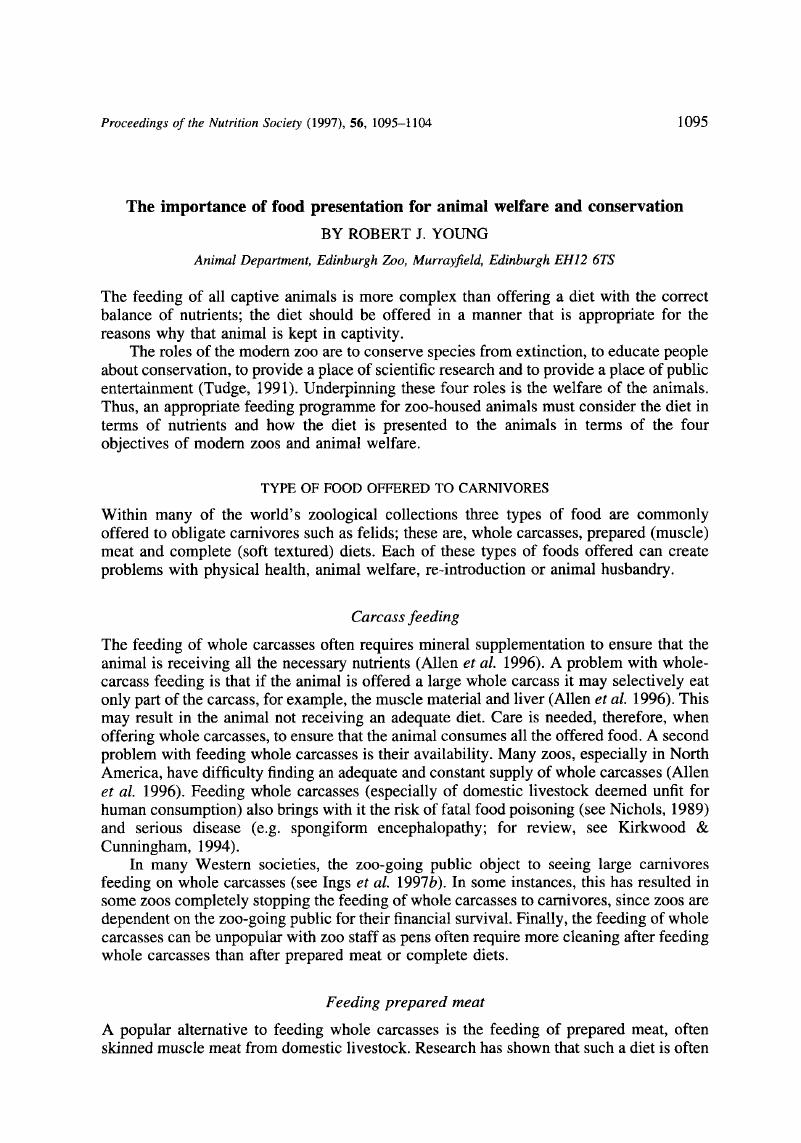Crossref Citations
This article has been cited by the following publications. This list is generated based on data provided by Crossref.
Holt, William V.
Pickard, Amanda R.
Rodger, John C.
and
Wildt, David E.
2002.
Reproductive Science and Integrated Conservation.
p.
21.
McEvoy, Tom G.
and
Robinson, John J.
2002.
Reproductive Science and Integrated Conservation.
p.
42.
Knobel, D.L
and
du Toit, J.T
2003.
The influence of pack social structure on oral rabies vaccination coverage in captive African wild dogs (Lycaon pictus).
Applied Animal Behaviour Science,
Vol. 80,
Issue. 1,
p.
61.
2003.
Environmental Enrichment for Captive Animals.
p.
184.
Meehan, Cheryl L.
and
Mench, Joy A.
2007.
The challenge of challenge: Can problem solving opportunities enhance animal welfare?.
Applied Animal Behaviour Science,
Vol. 102,
Issue. 3-4,
p.
246.
Sauther, Michelle L.
and
Cuozzo, Frank P.
2007.
Somatic Variation in Living, Wild Ring-Tailed Lemurs (Lemur catta).
Folia Primatologica,
Vol. 79,
Issue. 2,
p.
55.
Vargas-Ashby, HE
and
Pankhurst, SJ
2007.
Effects of feeding enrichment on the behaviour and welfare of captive Waldrapps (Northern bald ibis) (Geronticus eremita).
Animal Welfare,
Vol. 16,
Issue. 3,
p.
369.
Fernandez, Loraine Tarou
Bashaw, Meredith J.
Sartor, Richard L.
Bouwens, Nichole R.
and
Maki, Todd S.
2008.
Tongue twisters: feeding enrichment to reduce oral stereotypy in giraffe.
Zoo Biology,
Vol. 27,
Issue. 3,
p.
200.
Schipper, Lidewij L.
Vinke, Claudia M.
Schilder, Matthijs B.H.
and
Spruijt, Berry M.
2008.
The effect of feeding enrichment toys on the behaviour of kennelled dogs (Canis familiaris).
Applied Animal Behaviour Science,
Vol. 114,
Issue. 1-2,
p.
182.
Catibog-Sinha, Corazon
2008.
Zoo Tourism: Biodiversity Conservation Through Tourism.
Journal of Ecotourism,
Vol. 7,
Issue. 2-3,
p.
160.
McGowan, Ragen T. S.
Robbins, Charles T.
Alldredge, J. Richard
and
Newberry, Ruth C.
2010.
Contrafreeloading in grizzly bears: implications for captive foraging enrichment.
Zoo Biology,
Vol. 29,
Issue. 4,
p.
484.
Hoy, Julia M.
Murray, Peter J.
and
Tribe, Andrew
2010.
Thirty years later: enrichment practices for captive mammals.
Zoo Biology,
Vol. 29,
Issue. 3,
p.
303.
Cuozzo, Frank P.
Sauther, Michelle L.
Gould, Lisa
Sussman, Robert W.
Villers, Lynne M.
and
Lent, Cheryl
2010.
Variation in dental wear and tooth loss among known‐aged, older ring‐tailed lemurs (Lemur catta): a comparison between wild and captive individuals.
American Journal of Primatology,
Vol. 72,
Issue. 11,
p.
1026.
Reading, Richard P.
Miller, Brian
and
Shepherdson, David
2013.
The Value of Enrichment to Reintroduction Success.
Zoo Biology,
Vol. 32,
Issue. 3,
p.
332.
Quiroga-Carmona, Marcial
and
Naveda-Rodríguez, Adrián
2014.
Crested Quetzal (Pharomachrus antisianus) preying on a Glassfrog (Anura, Centrolenidae) in Sierra de Perijá, northwestern Venezuela.
Revista Brasileira de Ornitologia,
Vol. 22,
Issue. 4,
p.
419.
Fonseca, Ivana
Passos, Renata
Araujo, Fernanda
Lima, Milene
Lacerda, Debora
Pires, Washington
Soares, Danusa
Young, Robert
and
Rodrigues, Luiz
2014.
Exercising for food: bringing the laboratory closer to nature.
Journal of Experimental Biology,
Passos, Luiza F.
Mello, Humberto Espirito Santo
and
Young, Robert John
2014.
Enriching Tortoises: Assessing Color Preference.
Journal of Applied Animal Welfare Science,
Vol. 17,
Issue. 3,
p.
274.
Gaengler, Hannah
and
Clum, Nancy
2015.
Investigating the impact of large carcass feeding on the behavior of captive Andean condors (Vultur gryphus) and its perception by zoo visitors.
Zoo Biology,
Vol. 34,
Issue. 2,
p.
118.
Williams, Emma
Cabana, Francis
and
Nekaris, K. A. I.
2015.
Improving diet and activity of insectivorous primates in captivity: Naturalizing the diet of Northern Ceylon gray slender loris, Loris lydekkerianus nordicus.
Zoo Biology,
Vol. 34,
Issue. 5,
p.
473.
Dantas, Leticia MS
Delgado, Mikel M
Johnson, Ingrid
and
Buffington, CA Tony
2016.
Food puzzles for cats.
Journal of Feline Medicine and Surgery,
Vol. 18,
Issue. 9,
p.
723.



